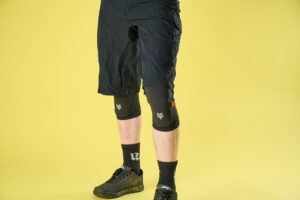Certainly looks the part
Boardman MTR 8.8 review
With smooth double pass welds and a matt finish the alloy frame on the mid-range Boardman MTR 8.8 could easily pass for carbon.
>>> Which Halfords mountain bike is right for you?
Even though Chris Boardman made his name in road racing, the band has always been synonymous with good quality, excellent value for money mountain bikes. It’s never quite captured the full suspension market though, so hopefully the new range of MTR bikes will address that.

Boardman MTR 8.8 review
They certainly look the part. It even has that distinct hump in the top tube that premium brands like Santa Cruz and Mondraker pioneered.
But it not just the styling and tube profiles of the Boardman that have been given a facelift, the geometry has been refreshed too. The head angle is over a degree slacker than the old Boardman Team FS we tested back in 2016. The chain stays have also had a nip and tuck to make them 5mm shorter, while the front centre grows by 20mm. All positive revisions then.
It’s still got a quick release rear end though, but it has been boosted from 135mm to the lasted 141mm standard. It also retains the relatively slack seat angle that we complained about when we tested its predecessor, but at least the seat post now has less lay back, so even with the short rear end taller riders won’t be too far over the rear axle when climbing. And with four distinct sizes and a women’s specific option, Boardman has everyone covered.

Rear shock was over-damped, yielding a flat ride
Suspension
Boardman claims that the travel on the MTR 8.8 has increased to 140mm, 10mm more than the old Team FS. When we measured it in our workshop however, we got 131mm. Boardman is not alone in exaggerating the amount of travel its bike pumps out, but it’s never nice to feel short-changed.
The new bike has switched to the latest RockShox Deluxe shock to take advantage of the metric sizing, which offers increased overlap and better durability. Boardman hasn’t quite nailed the shock tune though, as the rear end on the MTR 8.8 felt over damped and lifeless.
Up front, the 140mm travel RockShox Recon RL took everything we could throw at it. Guide pressures on the back of the fork lowers make it easy to achieve a ball park set-up, but the fork definitely performs best with the rebound set faster, which only serves to highlight the disparity between the performance of the front and rear suspension.

Quick-release rear end now uses the 141mm standard
Components
With 1×11 now commonplace on entry-level bikes, it’s a bold move fitting a 1×10 Shimano drivetrain to any bike. The number of gears isn’t really of concern though, and we love the low profile design of the Shimano Shadow+ rear mech as it makes it less exposed and less likely to get ripped of on a rock or tree stump.
What Boardman got wrong was actually the gear ratio. With a narrow range 11-42t cassette you need a relatively small chain ring up front of you’re not going to be off the bike and pushing up the steepest climbs. Boardman fitted a 34t chain ring, which is fine for spinning along black top but far from ideal for big days in the hills.

Wide rims help pump up the Boardman’s footprint
Performance
Boardman really should have cleaned up in this test. Not only is it the most expensive bike here, but having suspension at both ends combined with modern geometry gave it a massive advantage over similar price hardtails.
An advantage that was squandered by poor component choices. The main one being the shock tune. Over damped in both compression and rebound made the bike pedal efficiently, but it also robbed it of performance and made it impossible to get a balanced response between the front and rear suspension.
In fact, the Boardman suffers from similar shortcomings to the Jamis Dakar A2 we test a couple of months back. Namely poor tyre choice and an over damped shock.
The Jamis is £200 cheaper though and the shock tune isn’t as far off the mark as the Boardman. We gave that bike a 9 rating so were left with no choice but to score the Boardman an 8.

















